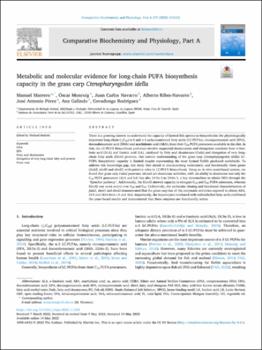Metabolic and molecular evidence for long-chain PUFA biosynthesis capacity in the grass carp Ctenopharyngodon idella
Date
2022Abstract
There is a growing interest to understand the capacity of farmed fish species to biosynthesise the physiologically
important long-chain (≥C20) n-3 and n-6 polyunsaturated fatty acids (LC-PUFAs), eicosapentaenoic acid (EPA),
docosahexaenoic acid (DHA) and arachidonic acid (ARA), from their C18 PUFA precursors available in the diet. In
fish, the LC-PUFA biosynthesis pathways involve sequential desaturation and elongation reactions from α-linolenic
acid (ALA) and linoleic acid (LA), catalysed by fatty acyl desaturases (Fads) and elongation of very longchain
fatty acids (Elovl) proteins. Our current understanding of the grass carp (Ctenopharyngodon idella) LCPUFA
biosynthetic capacity is limited despite representing the most farmed finfish produced worldwide. To
address this knowledge gap, this study first aimed at characterising molecularly and functionally three genes
(fads2, elovl5 and elovl2) with putative roles in LC-PUFA biosynthesis. Using an in vitro yeast-based system, we
found that grass carp Fads2 possesses Δ8 and Δ5 desaturase activities, with Δ6 ability to desaturase not only the
C18 PUFA precursors (ALA and LA) but also 24:5n-3 to 24:6n-3, a key intermediate to obtain DHA through the
“Sprecher pathway”. Additionally, the Elovl5 showed capacity to elongate C18 and C20 PUFA substrates, whereas
Elovl2 was more active over C20 and C22. Collectively, the molecular cloning and functional characterisation of
fads2, elovl5 and elovl2 demonstrated that the grass carp has all the enzymatic activities required to obtain ARA,
EPA and DHA from LA and ALA. Importantly, the hepatocytes incubated with radiolabelled fatty acids confirmed
the yeast-based results and demonstrated that these enzymes are functionally active.





